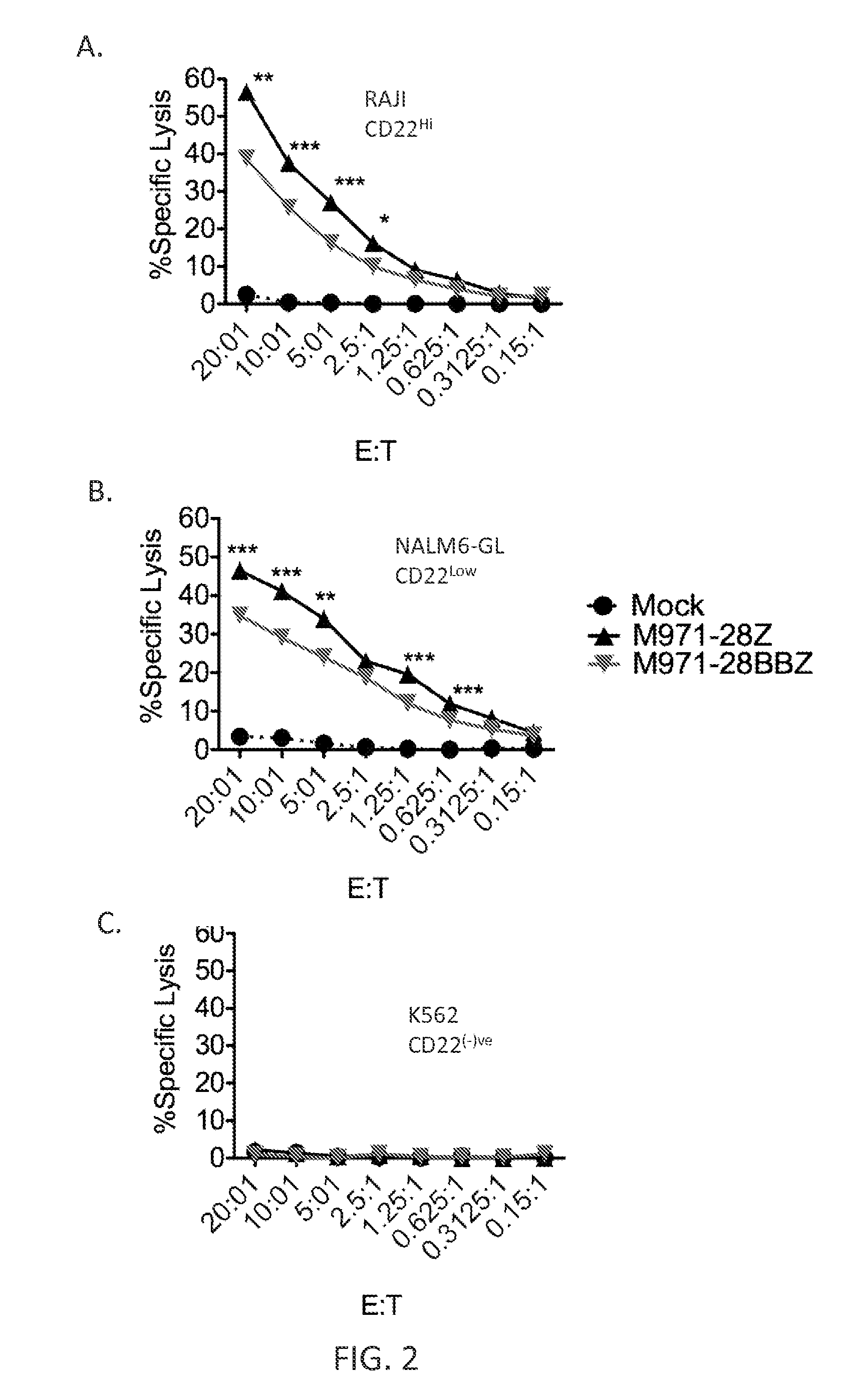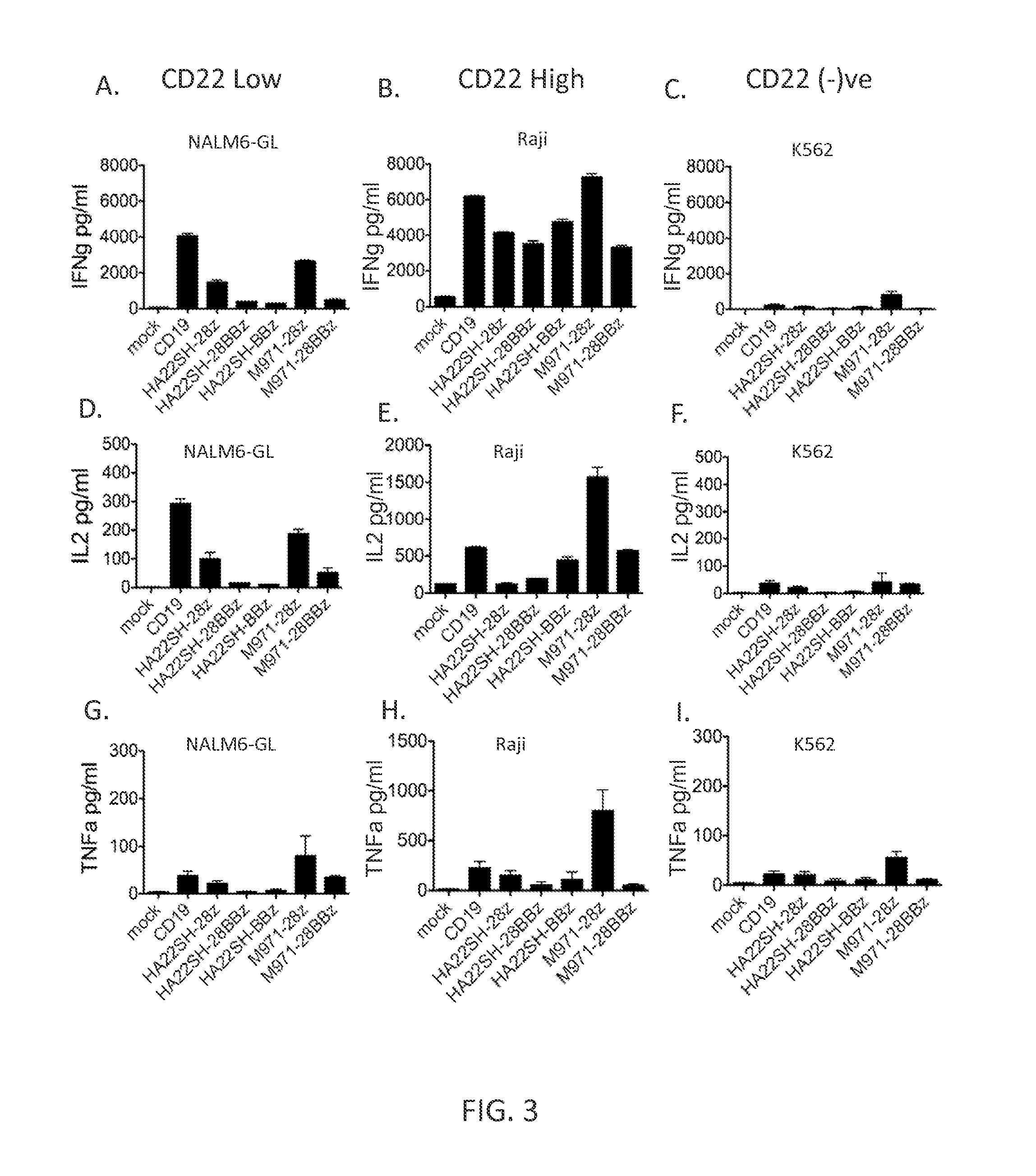M971 chimeric antigen receptors
- Summary
- Abstract
- Description
- Claims
- Application Information
AI Technical Summary
Benefits of technology
Problems solved by technology
Method used
Image
Examples
example 1
[0118]This example demonstrates the synthesis of anti-CD22 CARs, transduction of PBMC with anti-CD22 CARs, and analysis of CAR surface expression on transduced PBMC.
[0119]CAR-encoding sequences were synthesized using codon-optimization algorithms (Mr. Gene GmBH, Regensburg, Germany) and subcloned into “destination” vectors as described in (Zhao et al., J. Immunol., 183(9):5563-74 (2009)) encoding a first version second generation CAR (CD28 transmembrane and intracellular T cell signaling domains and CD3-zeta chain intracellular T cell signaling domain), second version second generation CAR (CD8 transmembrane domain linked to CD137 and CD3-zeta T cell signaling domains), or a third generation CAR (CD8 transmembrane domain linked to CD28, CD137, and CD3-zeta intracellular T cell signaling domains) sequences as shown in Table A.
TABLE AAntigenBindingSEQ ID NO:DomainFurther ComponentsHA22CAR-secondHA22CH2CH3generation, version 1CD28 transmembrane domainCD28 and CD3ζ intracellular T cell ...
example 2
[0122]This example demonstrates the expression of CD22 and CD19 antigens on leukemia cell lines.
[0123]Human leukemia cell lines (REH, SEM, NALM6, KOPN8, Daudi, Raji, and K562) were evaluated for the expression level of CD19 and CD22 on the cell surface using QUANTI-BRITE PE beads (BD Biosciences) and PE-labeled anti-CD19 and anti-CD22 antibody (Table 2). “Receptor Number Per Cell” indicates the approximate absolute number of molecules per cell on each of the indicated cell lines. Data were calculated by determining antibodies bound per cell (ABC) using the CELLQUEST software (BD) data analysis tools in accordance with the manufacturer's instructions.
TABLE 2Leukemia Cell LineReceptor Number Per CellREH CD1915,100SEM CD1950,800NALM-6 CD1950,500KOPN-8 CD1960,800Daudi CD1915,000Raji CD1950,000K562 CD19REH CD227,000SEM CD227,000NALM-6 CD228,000KOPN-8 CD2215,300Daudi CD228,000Raji CD2260,800K562 CD22
example 3
[0124]This example demonstrates the lytic activity of cells expressing the second generation (version 1) m971 CAR.
[0125]To determine the lytic activity, leukemia cell lines (REH, SEM, NALM6, KOPN8, Daudi, Raji, and K562) were 51Cr labeled and used as targets in cytotoxicity assays. Cells were untransduced (mock) or were transduced with the second generation (version 1) m971 CAR (SEQ ID NO: 23), the anti-CD19 CAR, or the second generation (version 1) HASH22 CAR and were used as effector cells at various effector to target ratios in the cytotoxicity assays. Percent lysis of the target cells was measured and is shown in FIG. 1A-1G.
[0126]As shown in FIGS. 1A-1G, the cells transduced with the second generation (version 1) m971 CAR (SEQ ID NO: 23) lysed CD22-expressing leukemia cell lines REH, SEM, NALM6, KOPN8, Daudi, and Raji, and did not lyse non-CD22 expressing cell line K562. Cells transduced with the second generation (version 1) m971 CAR (SEQ ID NO: 23) demonstrated superior lytic ...
PUM
| Property | Measurement | Unit |
|---|---|---|
| Magnetic field | aaaaa | aaaaa |
Abstract
Description
Claims
Application Information
 Login to View More
Login to View More - R&D
- Intellectual Property
- Life Sciences
- Materials
- Tech Scout
- Unparalleled Data Quality
- Higher Quality Content
- 60% Fewer Hallucinations
Browse by: Latest US Patents, China's latest patents, Technical Efficacy Thesaurus, Application Domain, Technology Topic, Popular Technical Reports.
© 2025 PatSnap. All rights reserved.Legal|Privacy policy|Modern Slavery Act Transparency Statement|Sitemap|About US| Contact US: help@patsnap.com



